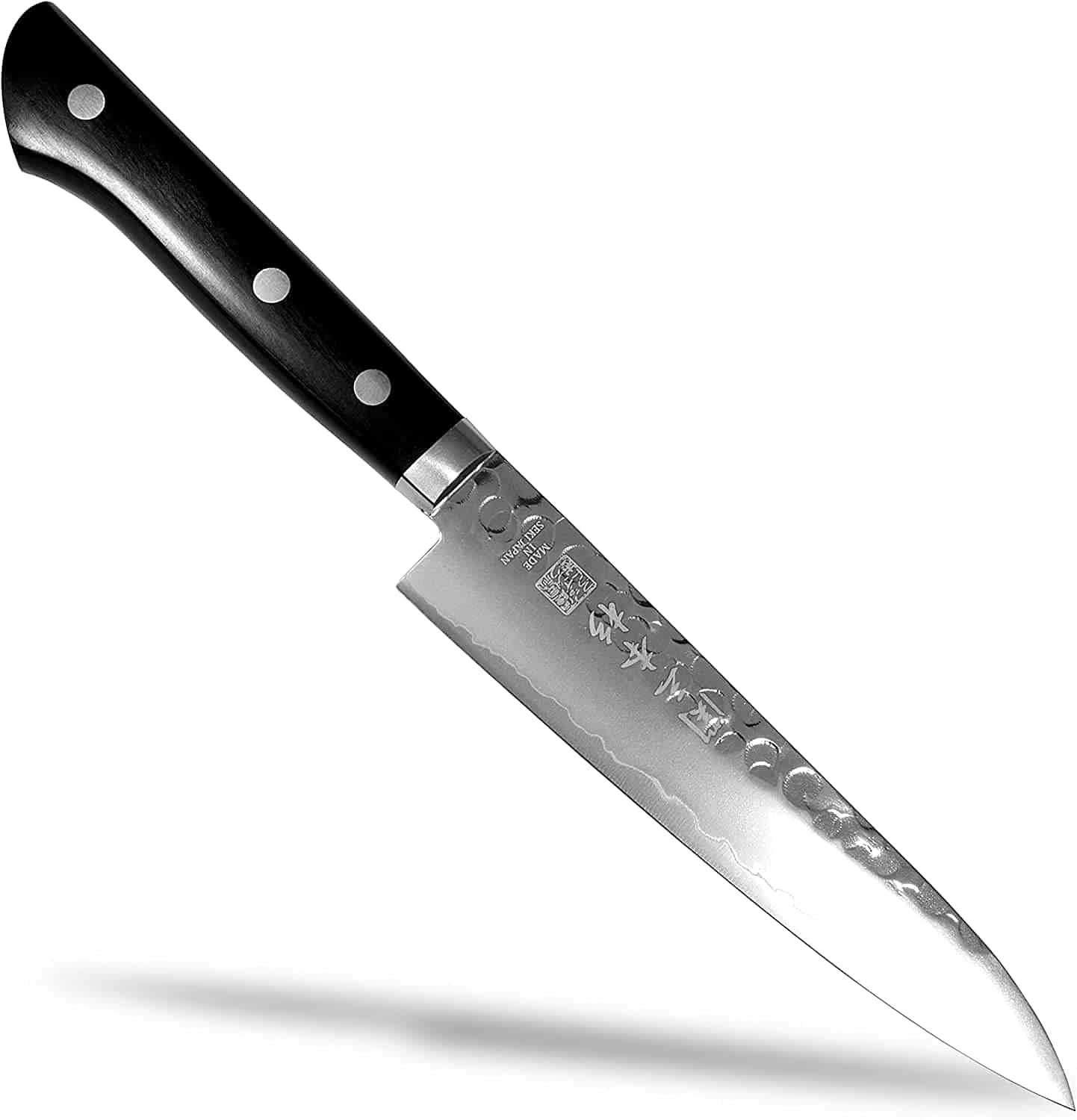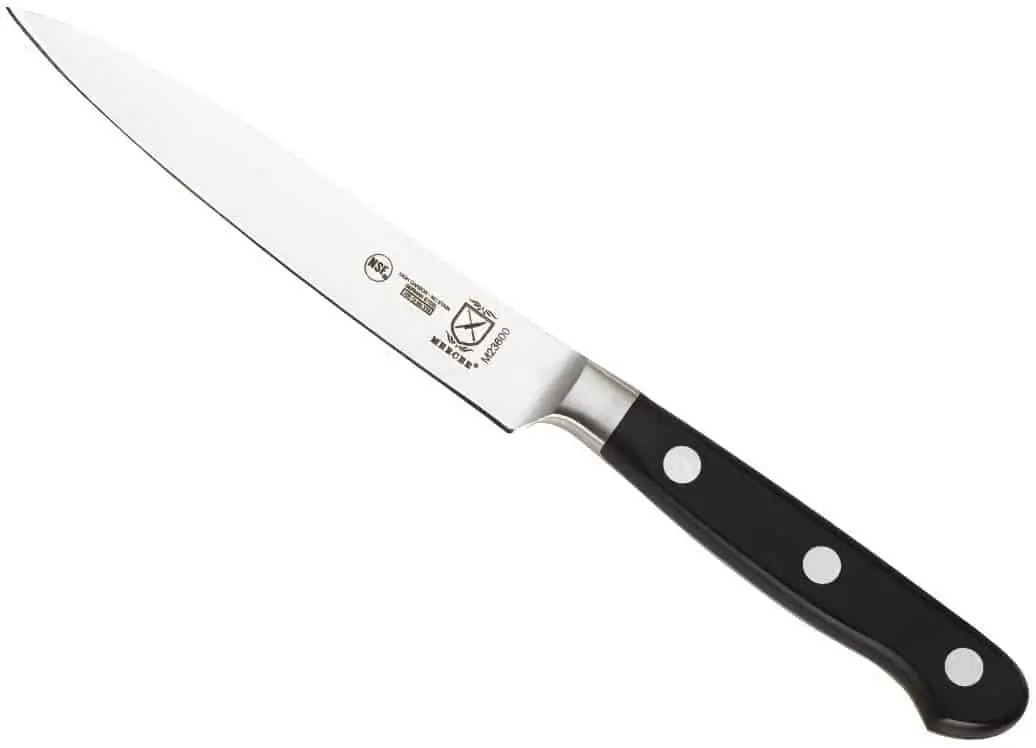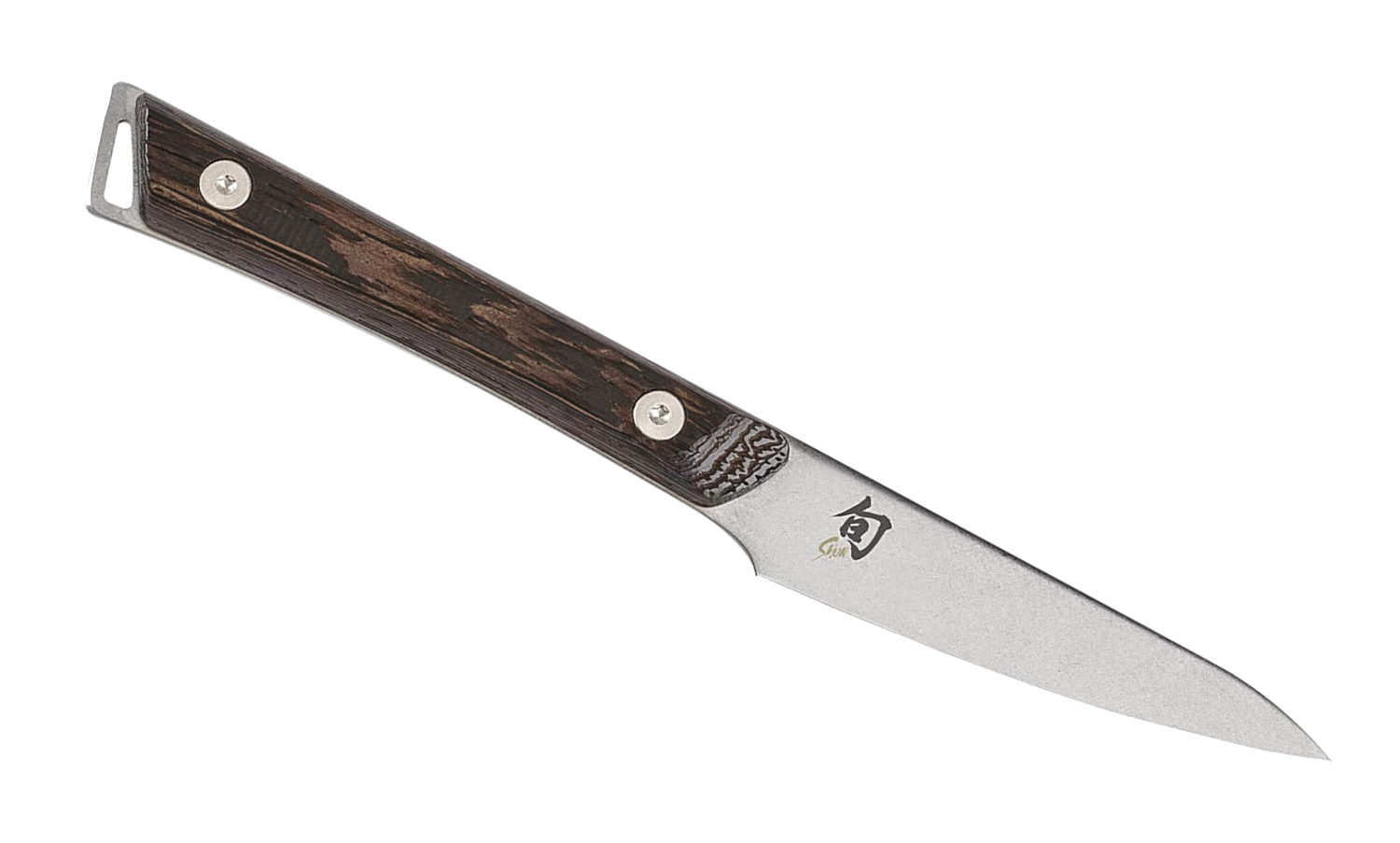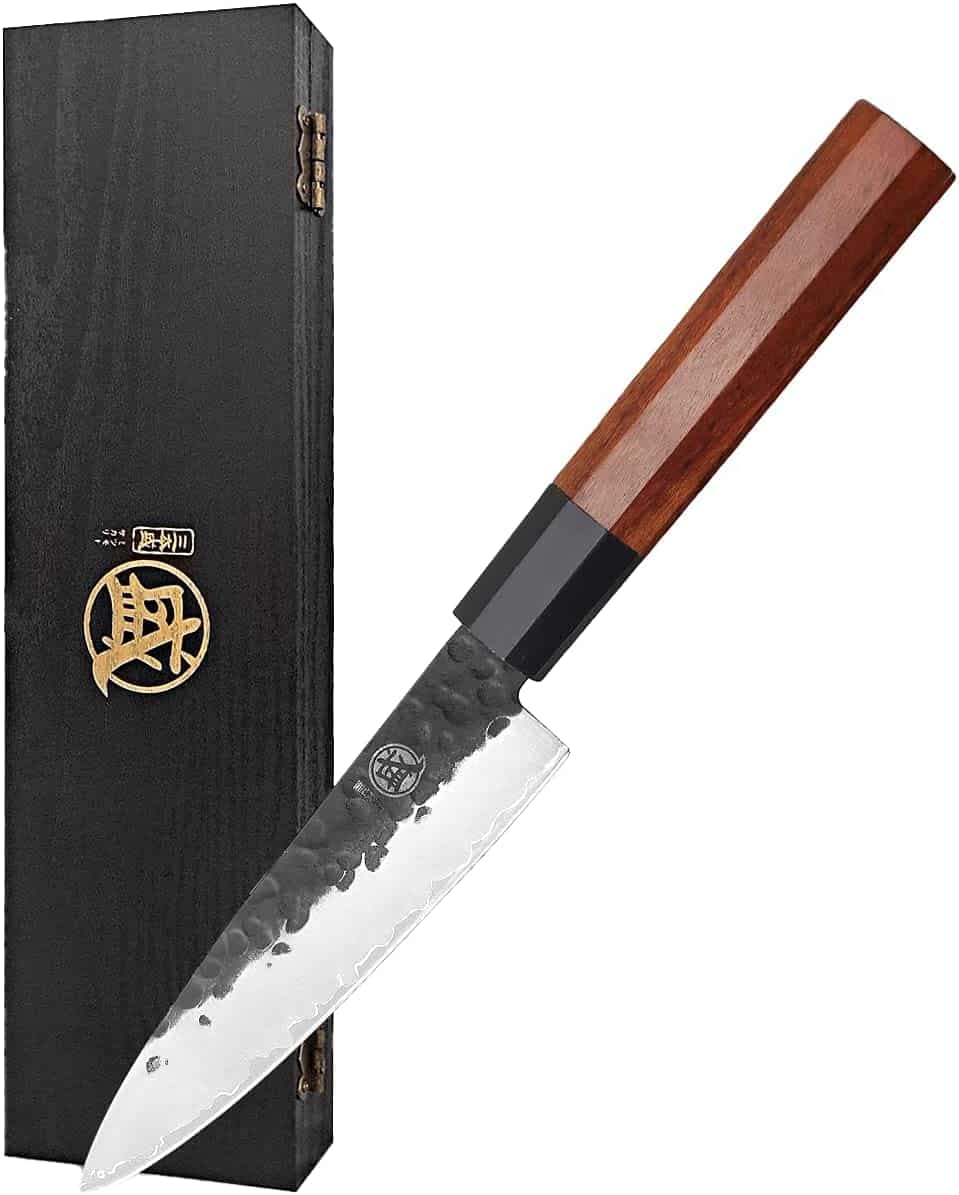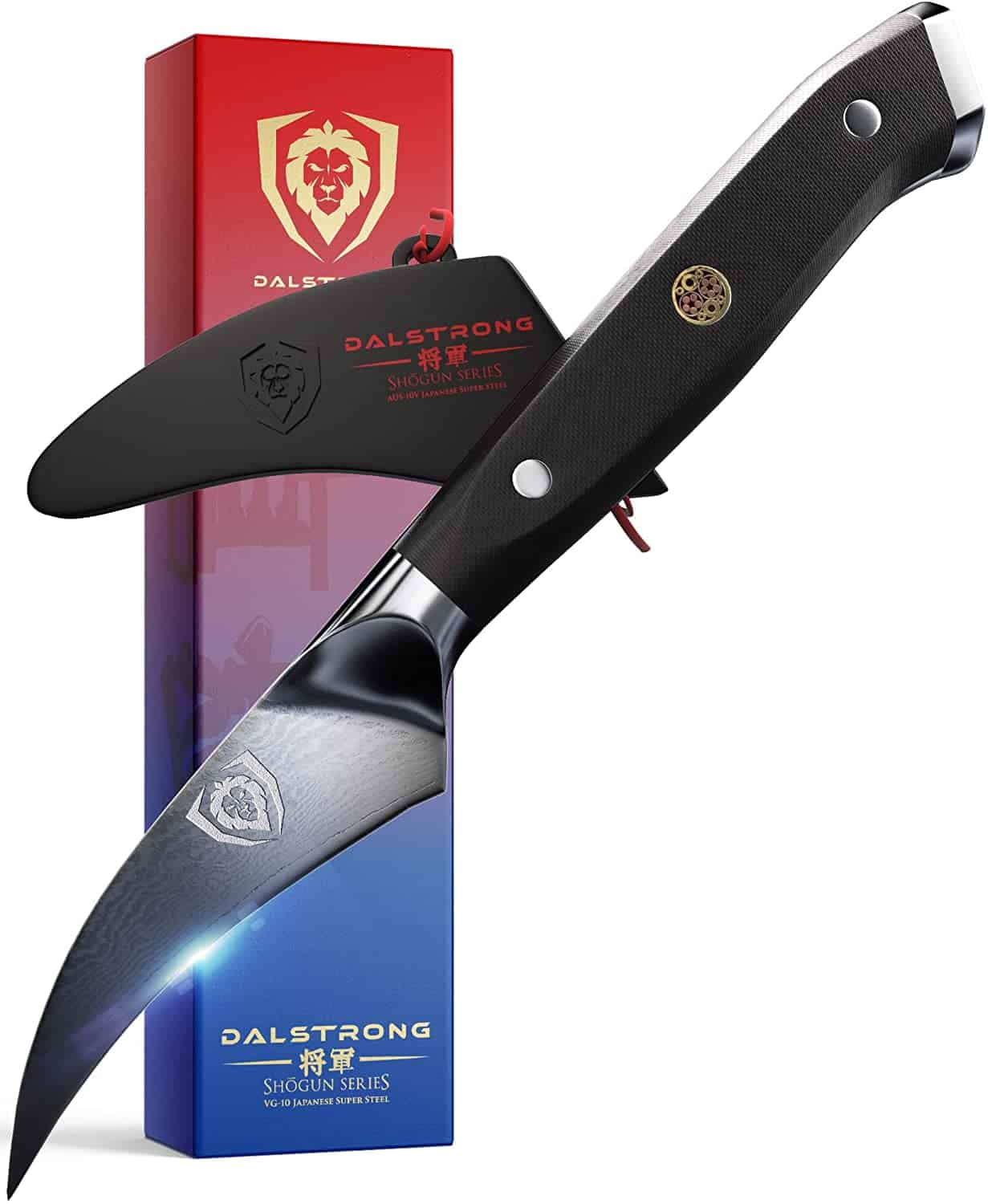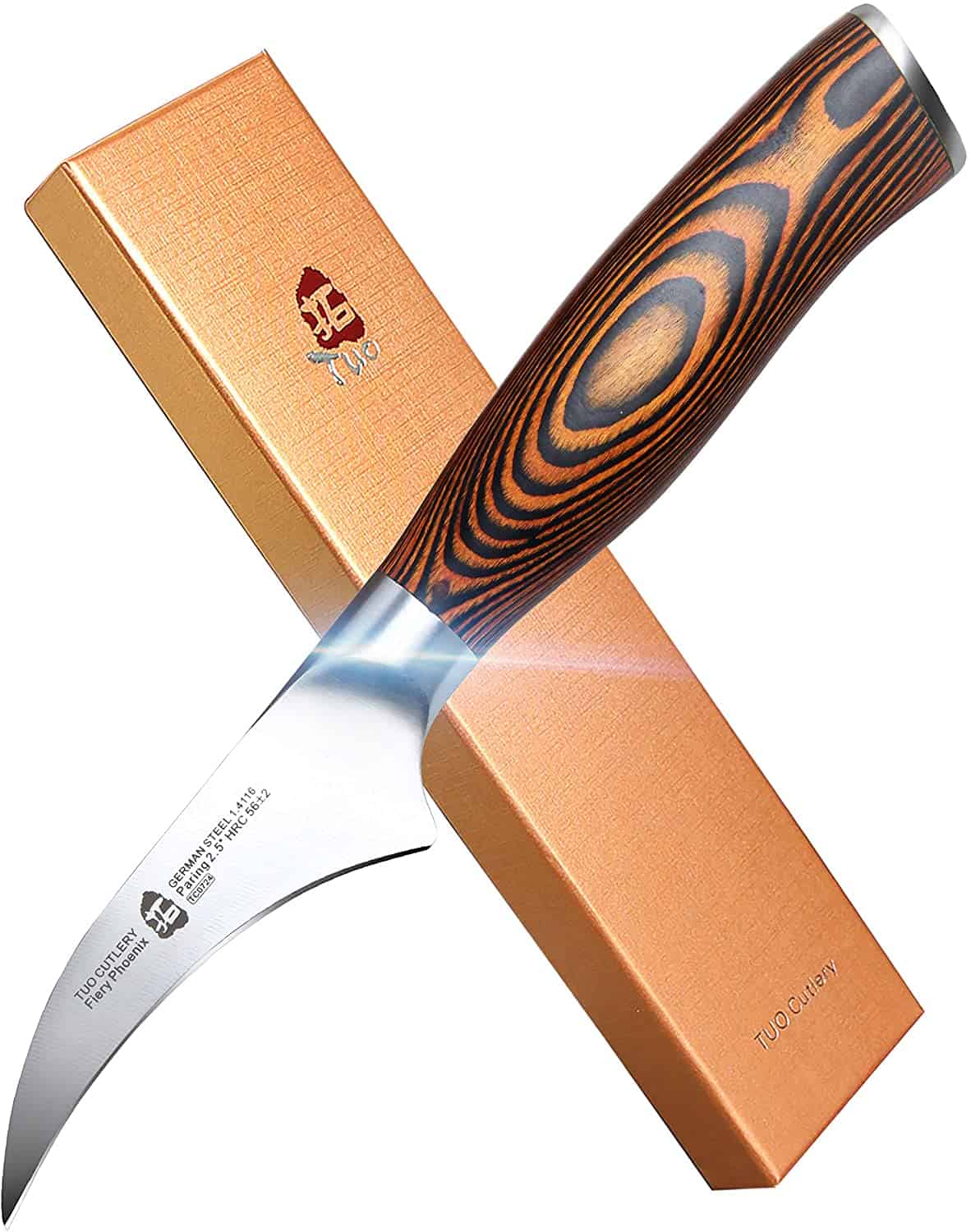6 Best Japanese Petty, Paring, Peeling Knives [Buying Guide]
If you’re looking for a versatile and multi-purpose knife, then you may want to consider a petty knife.
Petty knives are similar to paring knives, but they are larger in size. They can be used for a variety of tasks, such as slicing fruits and vegetables, mincing garlic, and even removing seeds from pumpkins.
Paring knives, on the other hand, are smaller in size and ideal for delicate tasks such as peeling apples or removing the core from a pineapple.
Peeling knives are even smaller than paring knives and are specifically designed for peeling fruits and vegetables.
You can even get away with cutting and slicing chicken or fish with any of these knives.

Whether you’re making vegan recipes all the time, or just looking for a small Japanese knife that can handle all fruit and vegetable prep tasks, you can’t go wrong with a petty knife like the Seki SANBONSUGI Utility Petty Knife because it’s the perfect size for those hard cutting and peeling tasks where precision is important.
Don’t worry, I’m reviewing petty, paring, and peeling knives because there are differences between them even if they seem identical at first glance.
Check out the table with all the petty, paring, and peeling knife options, and continue reading for the full reviews.
Best overall petty knife
The blade has an angled and pointed tip which is a feature of authentic Japanese petty knives. This allows for more precise cuts and you won’t have any problems removing hulls.
Best budget petty knife
This 5-inch petty knife is good for all types of cutting tasks, especially slicing fruit and vegetables. It has a straight tip though so it’s not as precise as the Seki.
Best paring knife
You can tell by the rustic design that it’s a high-quality, durable paring knife. The sharpness of this Shun knife is incredible – it can slice through anything effortlessly.
Best budget paring knife
This knife is made of high carbon steel, which means it’s very sharp and holds its edge well. It also has a beautiful hammered finish, so it looks much more expensive than it is.
Best peeling knife
The DALSTRONG Tourne Peeling-Paring Knife has a short 3″ curved blade, making it the perfect tool for peeling and carving round fruits and vegetables.
Best budget peeling knife

Check out our new cookbook
Bitemybun's family recipes with complete meal planner and recipe guide.
Try it out for free with Kindle Unlimited:
Read for freeIn this post we'll cover:
Buying guide
When choosing a Japanese petty, paring, or peeling knife, it is important to consider a few different factors. These include the length and shape of the blade, as well as the material it is made from.
Here’s a list of important features to look out for:
Type of knife
First, it’s best to determine which of the 3 types of knives you need. Perhaps you are looking for all three. But, generally, the petty knife is more “multi-purpose” and versatile.
The paring knife is excellent for slicing vegetables and herbs or cutting up fruit into smaller pieces. It’s a must-have knife for vegetarians and vegans.
Finally, if your main concern is peeling fruits and veggies and you want to make your life easier, I recommend the peeling knife.
Blade material
The next important consideration is the type of material used for the blade.
Stainless steel
Most of the knives have either a Japanese or German stainless steel blade. There are pros and cons to both materials.
Japanese stainless steel is often considered to be tougher and more durable than German stainless steel.
However, it is also more likely to rust if not properly cared for.
German stainless steel, on the other hand, is less likely to rust but not as tough as Japanese stainless steel.
High-carbon steel
If you are looking for a knife that is extremely sharp and easy to maintain, I recommend a high-carbon steel blade.
However, these knives do require more care because they can rust if not properly dried after use.
High-carbon steel blades can have a number of different finishes but this type of steel is best if you want a razor-sharp knife.
Knife size & blade length
Since petty knives are meant to be smaller in size, their blade shouldn’t be too long. A good size for most people is between four and six inches total for the whole knife.
Smaller knives are lighter and more appropriate for fine work.
We recommend a Petty knife with a blade length of 6 inches or less. It serves primarily as a fine-work supplementary knife to the main one.
The shorter blade length makes these knives special and that’s why you can do the more precise cutting.
If the blade is longer, it will function as a gyuto or other knife and not a true petty knife which defeats the purpose.
Those who intend to use their Petty as their primary all-purpose knife should opt for the largest petty knife however I still recommend a separate multi-purpose chef’s knife.
As long as the food isn’t too big, you can use a petty knife too as a multi-purpose knife to cut through meat, fish, and vegetables with no problem.
Those with small hands and a small kitchen will find a petty knife most useful.
Bevel
Almost all Japanese petty knives are double-bevel which means that they can be used by both right-handed and left-handed individuals.
Also, it means they are sharp on both sides of the blade.
A few models are available with a single bevel which is only meant to be used by those who are right-handed.
The double bevel edge, combined with the shorter blade lengths makes these petty knives better than your average Western utility knife.
Most other Japanese knives are single beveled though, so lefties need specific knives in their knife collections
Handle
Traditional Japanese knives have a wooden (Wa) handle, but you can also find models that use a variation of the Western-style handle.
If you prefer traditional Japanese knives, look for one with a wooden handle. Magnolia wood and rosewood are popular materials.
But these days military-grade and pakkawood handles are also very popular because they’re hygienic and easy to clean.
However, if you prefer to cook with Western-style knives, then choose a knife with a sturdy plastic or metal handle that fits comfortably in your hand.
A good knife should have a comfortable handle that is easy to grip.
The shape of the handle will also play a role in how comfortable it is to hold.
Some handles are designed to fit the contours of your hand, while others are more straight and simple.
Best 6 Japanese petty, paring and peeling knives reviewed
Now we have the differences between these types of knives in view, let’s look at some of the best options on the market.
These choices all definitely deserve a place in your knife stand or magnetic knife strip.
Gifu Japanese Seki SANBONSUGI
- Authentic angled and pointed tip
- Lightweight
- Nice rosewood handle
- Single bevel, not suitable for left-handed use
- type: petty
- size: 4.7 inches
- bevel: single
- material: stainless steel
- handle: rosewood
If you need help with cutting tasks, the Seki Sanbonsugi is the overall best produce knife because it can be used for delicate as well as heavy-duty chopping, slicing, dicing, and mincing tasks.
This is the best petty knife or Japanese utility knife because of its superior cutting edge.
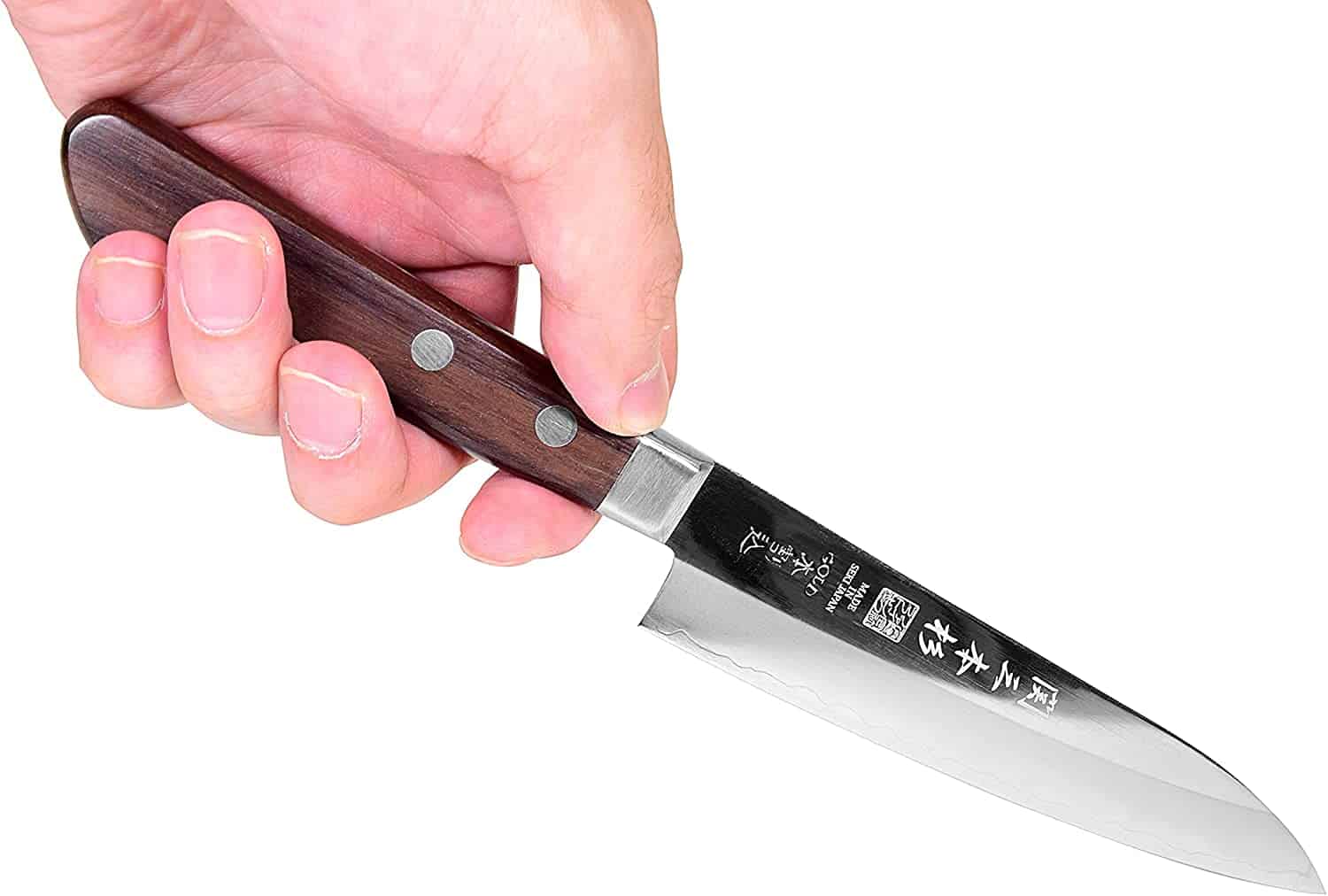
This knife is perfect for all your everyday tasks such as slicing vegetables, dicing tomatoes, and peeling fruits.
The blade has an angled and pointed tip which is a feature of authentic Japanese petty knives. This allows for more precise cuts and you won’t have any problems removing hulls.
Overall this knife is very good for decorative cutting of fruit and veggies or removing the hulls. It even removes and peels the skin from tough citrus fruit as well as apples and peaches.
Some people even use this knife to quickly fillet chicken breast or fish.
This knife is single bevel so I recommend it for right-handed users but lefties can learn to use it too with some practice.
The blade is also made of high-quality stainless steel which is resistant to rust and corrosion.
In addition, the handle is made of rosewood which gives it a beautiful and classic look. The comfortable wooden handle fits perfectly in the hand, and the knife’s sharp blade will make short work of any task.
It’s surprising how lightweight this knife is, compared to a Masamune petty knife even though it has a sturdy wooden handle.
Seki is the cutlery capital of Japan and these knives are highly sought-after because of their excellent quality.
This knife is no exception and it’s one of the best Japanese petty knives you can buy. But, unlike some other knives, this one won’t break the bank.
The Sanbonsugi knife is most often compared to the Seki Masamune petty knife but that one has a plastic handle and doesn’t have an angled tip so it’s more like a small chef’s knife instead of a true petty knife.
That’s why the Sanbonsugi petty knife is more versatile and easier to use. I recommend getting a knife sheath for this knife to keep it in pristine condition during storage.
Mercer Culinary M23600 Renaissance
- Sharp high carbon steel blade
- Great value for money
- Not as sharp out of the box
- type: petty
- size: 5 inches
- bevel: double
- material: high carbon steel
- handle: Delrin polymer
If you’re not interested in pricy petty knives because you don’t use them all the time, Mercer’s Renaissance range is a good choice.
This 5-inch petty knife is good for all types of cutting tasks, especially slicing fruit and vegetables. It has a straight tip though so it’s not as precise as the Seki.
It’s also easy to sharpen and take care of using a Japanese whetstone or honing rod.
If you like to make your own burgers, you can also use this knife to slice through slippery foods like pickles, and pickled onions.
There’s one disadvantage though with this knife: it’s just not as good at mincing and crushing garlic and herbs as the sharper Japanese blades. But, for home use, this knife does more than you’d expect.
The blade is made of German high carbon steel which gives it a sharp edge that will last a long time with proper care.
However, users notice that the Mercer knife doesn’t hold its edge as well as a Japanese high-carbon knife. But, the Mercer blade is also stain and rust-resistant.
It has a surprisingly good stain resistance similar to a Damascus knife.
When you first open the knife box, it isn’t as sharp as it should be so you’ll need to sharpen the knife but it’s easy to hone.
This knife has a good sturdy handle made of an innovative material called Delrin. It’s a polymer that is strong and durable but also has a good grip so it won’t slip out of your hand.
The Mercer Culinary Renaissance is a good all-purpose knife that can be used for slicing and dicing vegetables, fruits, and meat. It’s a good knife to have in the kitchen if you’re on a budget.
It’s comparable to the Wusthof knives in both design and quality but this one stays sharper for longer and the blade doesn’t chip.
Also, this is a double-bevel knife so it’s suitable for use by right and left-handed people.
So, if you’re looking for an affordable alternative to expensive Japanese petty knives, this Mercer one is a good value buy.
Seki Sanbonsugi vs budget Mercer Renaissance petty knife
When it comes to Japanese petty knives, the Seki Sanbonsugi and budget Mercer Renaissance knives are two of the best options.
Both are high-quality knives made with high-carbon steel blades that stay sharp for a long time.
However, you can just tell that Sanbonsugi knives are made in Seki, Japan. The craftsmanship and edge retention of a Seki knife are superior.
The main difference between these two knives is that the Seki knife has an angled tip while the Mercer knife has a straight tip.
This makes the Seki knife more versatile and easier to use for slicing and dicing vegetables, fruits, and meat.
Also, the Mercer knife is a tiny bit larger than the Seki.
When it comes to the handles, the Seki knife has a traditional wood handle whereas the Mercer knife has a more modern polymer handle but it does look a bit cheaper.
The Mercer knife is a good all-purpose knife that can be used for slicing and dicing vegetables, fruits, and meat. It’s also a good choice for home cooks who don’t want to spend too much on a petty knife.
But, if you’re a chef looking for a professional knife the Sanbonsugi is the knife you need in your collection.
Shun Kanso 3.5-Inch
- Authentic Japanese style
- Very sharp AUS 10 high carbon steel
- Quite smalll compared to Western paring knives
- type: paring
- size: 3.5 inches
- bevel: double
- material: AUS 10 high carbon steel
- handle: Tagayasan wood
The Shun Kanso 3.5″ paring knife is very unique and special because it’s an authentic Japanese-style paring knife, not a Western one.
You can tell by the rustic design that it’s a high-quality, durable paring knife.
The sharpness of this Shun knife is incredible – it can slice through anything effortlessly.
Since it’s handmade, the knife has a very beautiful finish although it’s not Damascus like many people expect.
This knife is excellent for peeling, decorative cutting, and precision knife work. If you already have good Japanese knife skills, you can use this knife for a variety of kitchen tasks.
If you’re a beginner, you’ll find that it’s easy to learn with this knife because it has an incredibly sharp edge. Its shape and size also make it very versatile.
It’s worth noting that it’s quite small. If you’re used to Western-style paring knives, you may find the 3.5″ blade too short.
Although the knife is smaller than the petty knives it’s still a good size for slicing and dicing vegetables, fruits, and meat. You’ll be able to maneuver the knife with ease even as you’re using a cutting board.

The blade is made of AUS 10 high-carbon steel which means that it’s both very sharp and rust-resistant. It also stays sharp for a long time after honing or sharpening with a whetstone or honing rod.
The Shun paring knife is sharper than most of the paring knives you’ll come across and it’s known for having amazing edge retention.
The handle is made of Tagayasan wood which is a very strong and durable material.
It’s comfortable to hold and it won’t slip out of your hand even when it’s wet.
However, it’s a bit more rough-looking and feeling than other wooden-handled knives. So, I wouldn’t say this knife has the most ergonomic handle of them all.
One downside of this knife is that since it’s handmade, it’s quite expensive. But, it’s definitely worth the price if you’ve ever struggled to cut produce and peel all the skin off fruit and veggies.
Overall, this knife is very balanced, lightweight, and comfortable to use. It’s also very pretty to look at.
If you’re looking for an authentic Japanese paring knife, the Shun Kanso is the best option and it will definitely make your kitchen prep work a lot easier.
MITSUMOTO SAKARI 5.5 inch
- Hammered finish
- Great value for money
- Blade chips easily
- type: paring
- size: 5.5 inches
- bevel: double
- material: high carbon steel
- handle: rosewood
Depending on how often you cook, you might not need a premium-priced paring knife. The best alternative to the Shun is the Mitsumoto Sakari 5.5-inch paring knife.
Although it’s a larger knife than the Shun, this one is more versatile if you need to cut fruit and veg and fillet white meat and fish.
You won’t need to sharpen this knife as often as you would a Western-style paring knife.
This knife is made of high carbon steel, which means it’s very sharp and holds its edge well. It also has a beautiful hammered finish, so it looks much more expensive than it is.
The Mitsumoto knife is also rust-resistant, so you don’t have to worry about leaving it wet or damp. However, I always recommend hand washing and drying your Japanese knives immediately.
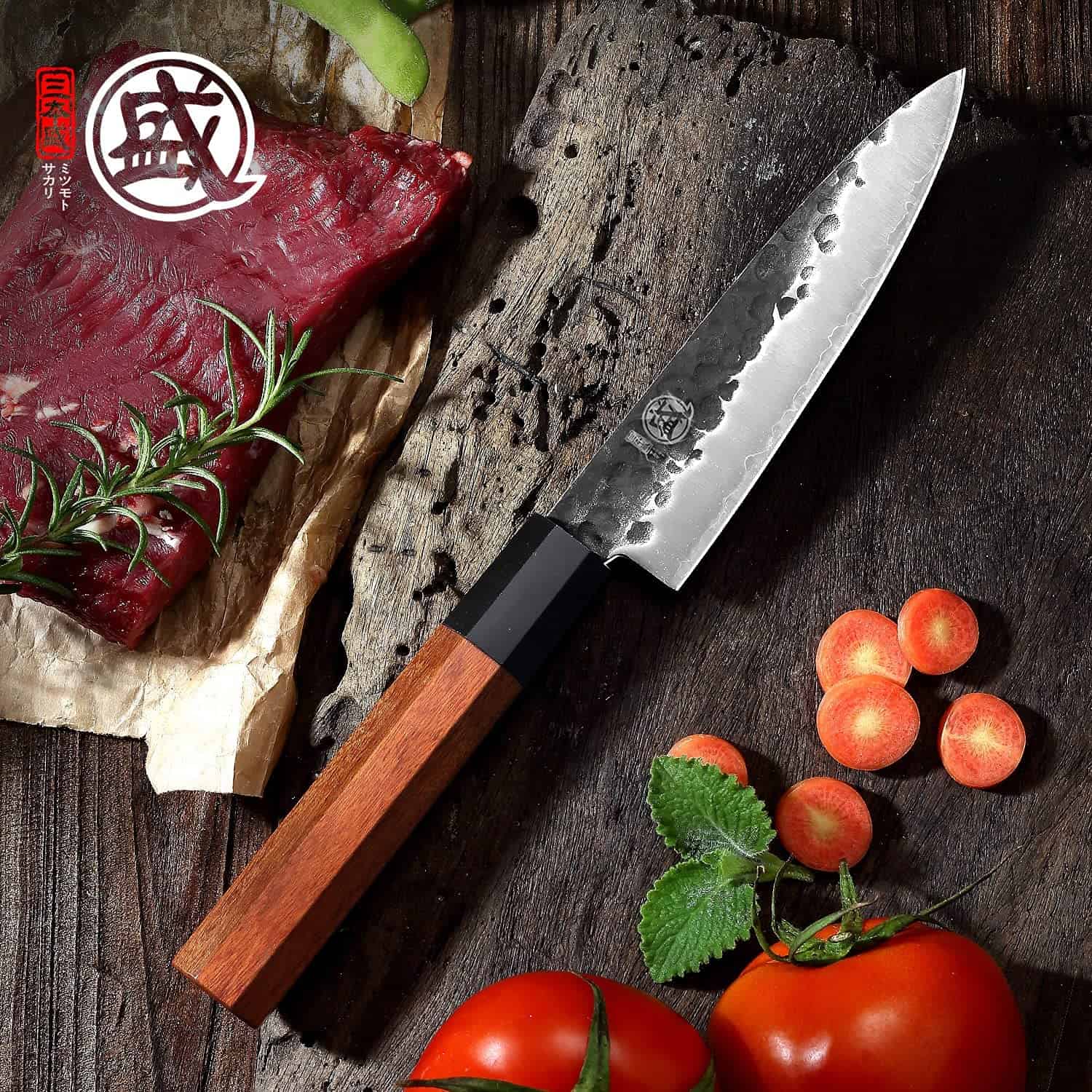
The bevel is double-edged, so it’s very sharp and user-friendly.
While it’s not quite as sharp as the Shun, the Mitsumoto Sakari paring knife is still super sharp compared to Western knives.
What makes this knife special is that it has a slightly curved blade that prevents damage to ripe fruit when you cut through it.
You can even use this knife for skinning meat and seafood.
However, you need to be careful as you use the knife for chopping on cutting boards. The blade is strong but also prone to minor chipping if you are heavy-handed with it.
The handle is made of rosewood and has a traditional octagonal shape. It’s a bit less comfy than some other handles, but overall, the knife feels well balanced.
Many Westerners might find that this type isn’t as ergonomically shaped like the usual Western utility knife.
Shun Kanso vs Mitsumoto Sakari paring knife
The first noticeable difference between these knives is their shape.
The Shun Kanso paring knife has a straight blade with a super pointy tip, while the Mitsumoto Sakari features a slightly curved blade.
When it comes to fine decorative work such as paring fruit for displays and buffets, the Shun is definitely the better option.
But, if you need a bit more versatility in the kitchen and don’t use a paring knife daily, the Mitsumoto is the second-best Japanese paring knife.
The Shun is smaller at 3.5 inches, and the Mitsumoto is much longer, measuring about 5.5 inches.
Both knives are double-beveled with a 50/50 edge. However, the Shun is made of harder steel to hold its edge for longer between sharpenings. You can tell that Shun is a premium handmade blade because of its beautiful Tagayasan wood handle.
The Mitsumoto is also made of high carbon steel, but it’s not quite as hard as the Shun. As a result, this knife is more prone to chipping than the Shun.
However, if you’re on a budget and need a good paring knife that can do it all, the Mitsumoto Sakari is a perfect choice. It’s lightweight, extremely sharp, and holds its edge well.
DALSTRONG Tourne 3″
- Extremely sharp AUS 10 steel
- Non-stick finish
- G10 fiberglass resin handle
- Not very traditional
- type: peeling
- size: 3 inches
- bevel: double
- material: AUS 10 high carbon steel
- handle: G10
If you want to peel a lot of fruit and veggies quickly and efficiently, a dedicated peeling knife is the best option.
If you’re on a plant-based diet, you’ll need a knife that can get through the tough skins of carrots and apples without breaking them.
The DALSTRONG Tourne Peeling-Paring Knife has a short 3″ curved blade, making it the perfect tool for peeling and carving round fruits and vegetables.
It’s ideal if you’re making things like salads, tart cases, and other recipes where you need perfectly even pieces of fruit.
The preparation of small, round fruits and vegetables is made easier using this knife’s beak-like blade. You can flute mushrooms and peel even very small fruits and veggies.
The blade is made of high carbon AUS 10 steel, which is extremely sharp and can take a lot of abuse.
It’s also heat treated to Rockwell C hardness so that it will stay sharp for a long time. Also, this knife blade has a special Damascus finish, so it looks very nice.
Unlike cheaper peeling knives, the Damascus finish makes the blade less sticky, so the fruit and vegetable peels don’t stick to the sides of the blades. A non-stick blade is handy when peeling.
And, if you need to cut through food, you can get a very smooth cut with the DALSTRONG Tourne Peeling-Paring Knife. So, you can practically slice through a juicy peach without any problems.
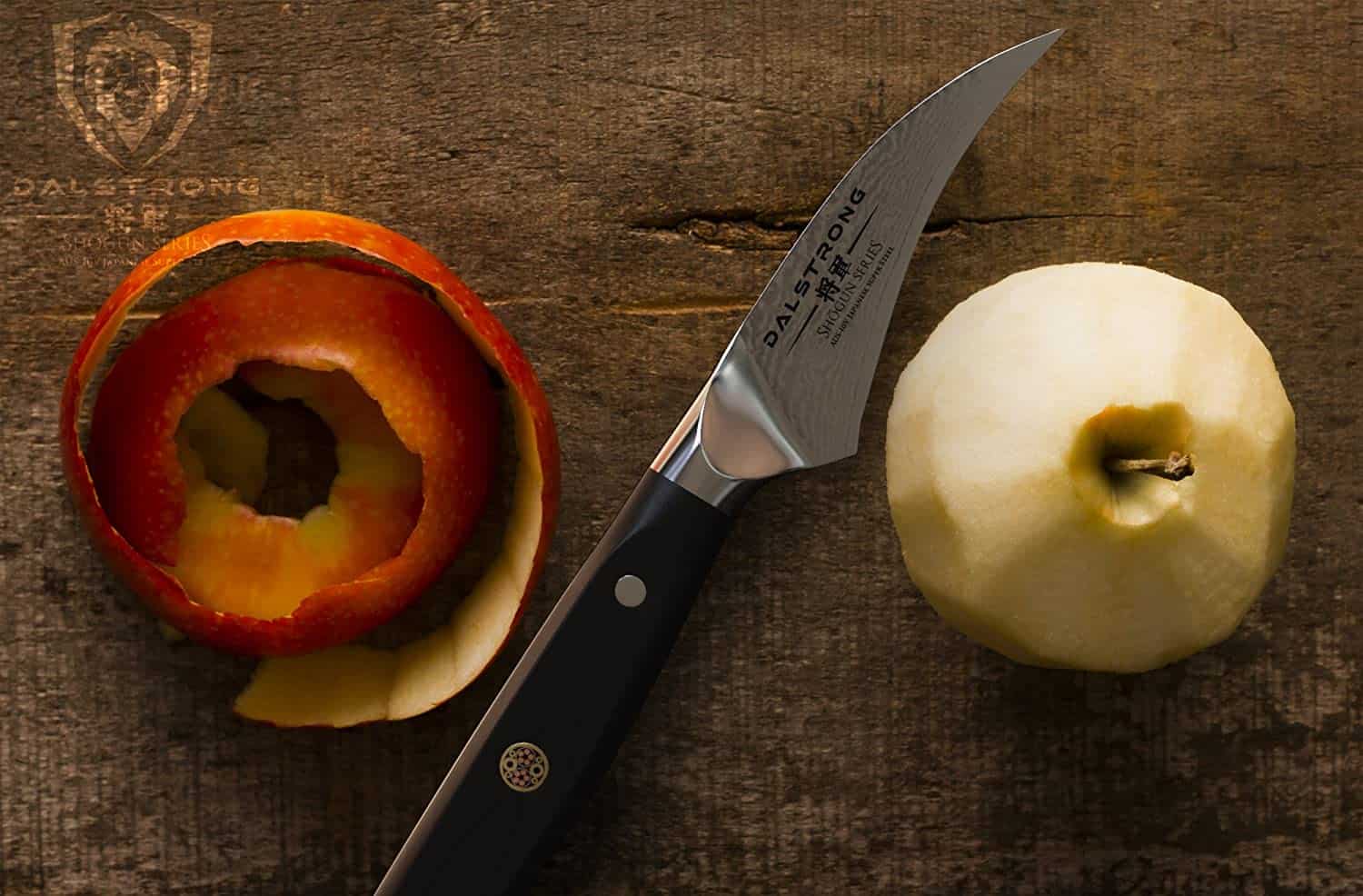
Although this blade is razor-sharp, it can be a bit blunt when you buy it, so give it a sharpen first and then be careful to avoid cutting your fingers because it’s incredibly sharp.
The handle is made of high-quality G10 (fiberglass resin) and is highly durable. It’s also ergonomically designed, so it fits comfortably in your hand.
TUO Bird-Beak
- Well-balanced with Full-tang blade
- Great value for money
- Made from German steel
- type: peeling
- size: 2.5 inches
- bevel: double
- material: German steel
- handle: pakkawood
If you’re looking for a small peeling knife you can take with you camping, hunting, fishing, or just to have around the kitchen; you don’t need to spend a lot of money.
This TUO knife also has a bird-beak type design like the Dalstrong, but it’s cheaper.
It measures only 2.5″ long and is made of German steel, so it will be able to take a lot of wear and tear while you’re out in the wilderness or struggling with that pesky nectarine.
People like to use this knife to cut out those stubborn roots in potatoes. With the knife’s, pointed sharp tip, such tasks are easy and safe.
If you struggle to peel, cut, or remove the core and seeds of apples with just one knife, you need to try the TUO peeling knife because it’s small enough, and the blade is slightly flexible so you can get it into those hard to reach places easily.
This knife is designed for peeling fruits and veggies but can also be used like a paring knife or steak knife if required.
The blade is full-tang, meaning it’s one solid piece of steel that goes all the way through the handle. This means it will be very durable and won’t break easily like cheaper knives, even though it’s in the “budget” category.
The handle is made of ergonomic and easy to clean pakkawood, which feels good in the hand.

The craftsmanship of this knife isn’t entirely up to par with brands like Yoshihiro or Shun, but you can expect good results, and the knife will last for several years.
Some customers say the blade is too flexible and can break if you use it with hard foods like yams.
If you’re on a budget but still want to enjoy a quality knife, the TUO Bird-Beak Paring Knife is perfect because it can compete with Dalstrong in terms of blade quality. It also has a compact size and long-lasting edge.
Dalstrong peeling knife vs budget TUO peeling knife
A notable difference between these two knives is the size. The Dalstrong knife is 3.5 inches long, while the TUO knife measures just 2.5 inches.
This means the Dalstrong knife is better for larger fruits and vegetables, while the TUO knife is better for smaller ones.
Another difference is in the blade material. The Dalstrong knife is made of high-carbon Japanese steel, while the TUO knife is made of German steel.
These knives also have different handles: the Dalstrong has a G10 handle, while the TUO has a pakkawood handle.
Finally, the Dalstrong knife is more expensive than the TUO knife.
Overall, if you’re looking for a peeling knife that can cut through larger fruits and perform skinning tasks, the Dalstrong is the more durable option.
If you’re on a budget and want something smaller and more versatile, the TUO Bird-Beak Paring Knife is a good option, and if you go traveling, you can take it with you.
Just beware that this smaller knife can’t handle a cutting task as well as a larger paring or petty knife.
For extra special carving tricks, you need a Mukimono chef’s knife like this one here
Takeaway
Overall, a Japanese petty, paring, or peeling knife is an essential tool for any home cook looking to prep fruits and vegetables with ease.
A petty knife like the Seki SANBONSUGI Utility Petty Knife can do almost all the tasks of a paring and peeling knife, so it’s the most versatile for the home kitchen.
Overall though, all the knives on this list have sharp blades, and the knife features you need to prep produce and some types of meat and seafood.
Whether you’re looking for a budget-friendly model or are willing to splurge on a high-end option, there is sure to be a knife that suits your needs.
So consider these factors when shopping for the best petty, paring, or peeling knife, and you’ll be well on your way to creating delicious meals in no time!
Read next: Best Copper Frying Pans Reviewed | from budget to top of the line
Check out our new cookbook
Bitemybun's family recipes with complete meal planner and recipe guide.
Try it out for free with Kindle Unlimited:
Read for freeJoost Nusselder, the founder of Bite My Bun is a content marketer, dad and loves trying out new food with Japanese food at the heart of his passion, and together with his team he's been creating in-depth blog articles since 2016 to help loyal readers with recipes and cooking tips.

